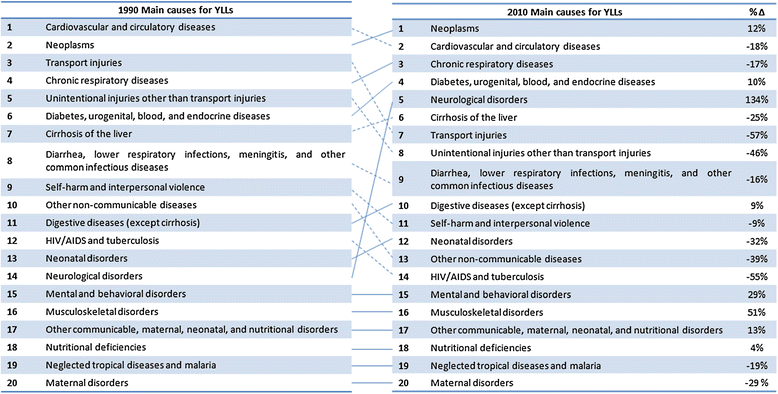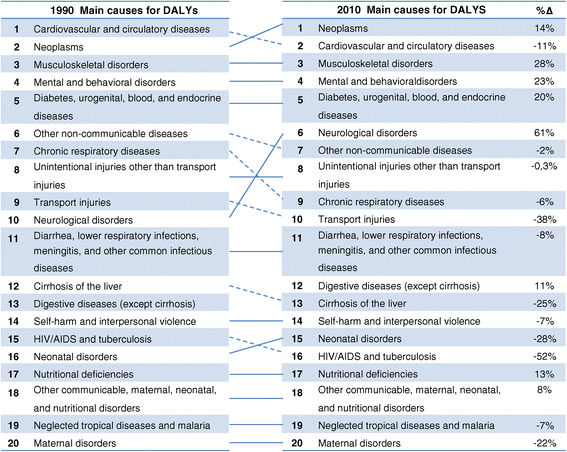The burden of disease in Spain: results from the global burden of disease study 2010
- PMID: 25480438
- PMCID: PMC4276068
- DOI: 10.1186/s12916-014-0236-9
The burden of disease in Spain: results from the global burden of disease study 2010
Abstract
Background: We herein evaluate the Spanish population's trends in health burden by comparing results of two Global Burden of Diseases, Injuries, and Risk Factors Studies (the GBD studies) performed 20 years apart.
Methods: Data is part of the GBD study for 1990 and 2010. We present results for mortality, years of life lost (YLLs), years lived with disability, and disability-adjusted life years (DALYs) for the Spanish population. Uncertainty intervals for all measures have been estimated.
Results: Non-communicable diseases accounted for 3,703,400 (95% CI 3,648,270-3,766,720) (91.3%) of 4,057,400 total deaths, in the Spanish population. Cardiovascular and circulatory diseases were the main cause of mortality among non-communicable diseases (34.7% of total deaths), followed by neoplasms (27.1% of total deaths). Neoplasms, cardiovascular and circulatory diseases, and chronic respiratory diseases were the top three leading causes for YLLs. The most important causes of DALYs in 2010 were neoplasms, cardiovascular and circulatory diseases, musculoskeletal disorders, and mental and behavioral disorders.
Conclusions: Mortality and disability in Spain have become even more linked to non-communicable diseases over the last years, following the worldwide trends. Cardiovascular and circulatory diseases, neoplasms, mental and behavioral disorders, and neurological disorders are the leading causes of mortality and disability. Specific focus is needed from health care providers and policy makers to develop health promotion and health education programs directed towards non-communicable disorders.
Figures





Similar articles
-
The burden of disease in Spain: Results from the Global Burden of Disease 2016.Med Clin (Barc). 2018 Sep 14;151(5):171-190. doi: 10.1016/j.medcli.2018.05.011. Epub 2018 Jul 20. Med Clin (Barc). 2018. PMID: 30037695 English, Spanish.
-
Global mortality, disability, and the contribution of risk factors: Global Burden of Disease Study.Lancet. 1997 May 17;349(9063):1436-42. doi: 10.1016/S0140-6736(96)07495-8. Lancet. 1997. PMID: 9164317
-
Alternative projections of mortality and disability by cause 1990-2020: Global Burden of Disease Study.Lancet. 1997 May 24;349(9064):1498-504. doi: 10.1016/S0140-6736(96)07492-2. Lancet. 1997. PMID: 9167458
-
Global burden of disease attributable to mental and substance use disorders: findings from the Global Burden of Disease Study 2010.Lancet. 2013 Nov 9;382(9904):1575-86. doi: 10.1016/S0140-6736(13)61611-6. Epub 2013 Aug 29. Lancet. 2013. PMID: 23993280 Review.
-
Measuring the burden of disease and injury in Spain using disability-adjusted life years: an updated and policy-oriented overview.Public Health. 2012 Dec;126(12):1024-31. doi: 10.1016/j.puhe.2012.08.012. Epub 2012 Oct 9. Public Health. 2012. PMID: 23062632 Review.
Cited by
-
Temporal Analysis of the Incidence, Mortality and Disability-Adjusted Life Years of Benign Gallbladder and Biliary Diseases in High-Income Nations, 1990-2019.Ann Surg Open. 2024 Jun 18;5(2):e453. doi: 10.1097/AS9.0000000000000453. eCollection 2024 Jun. Ann Surg Open. 2024. PMID: 38911626 Free PMC article.
-
Importance of Social- and Health-Related Problems: Do Spaniards Give Them the Significance They Actually Deserve?Int J Environ Res Public Health. 2019 Oct 24;16(21):4090. doi: 10.3390/ijerph16214090. Int J Environ Res Public Health. 2019. PMID: 31652925 Free PMC article.
-
Implementing a Care Pathway for Complex Chronic Patients from a Nursing Perspective: A Qualitative Study.Int J Environ Res Public Health. 2021 Jun 11;18(12):6324. doi: 10.3390/ijerph18126324. Int J Environ Res Public Health. 2021. PMID: 34207974 Free PMC article.
-
Alcohol-attributed disease burden and alcohol policies in the BRICS-countries during the years 1990-2013.J Glob Health. 2017 Jun;7(1):010404. doi: 10.7189/jogh.07.010404. J Glob Health. 2017. PMID: 28400952 Free PMC article.
-
Quality of Life and Dependence Degree of Chronic Patients in a Chronicity Care Model.Healthcare (Basel). 2020 Aug 24;8(3):293. doi: 10.3390/healthcare8030293. Healthcare (Basel). 2020. PMID: 32846995 Free PMC article.
References
-
- Murray CJ, Salomon JA, Mathers CD, Lopez AD. Summary Measures of Population Health: Concepts, Ethics, Measurement and Applications. Geneva: WHO; 2002.
-
- Lozano R, Naghavi M, Foreman K, Lim S, Shibuya K, Aboyans V, Abraham J, Adair T, Aggarwal R, Ahn SY, Alvarado M, Anderson HR, Anderson LM, Andrews KG, Atkinson C, Baddour LM, Barker-Collo S, Bartels DH, Bell ML, Benjamin EJ, Bennett D, Bhalla K, Bikbov B, Bin Abdulhak A, Birbeck G, Blyth F, Bolliger I, Boufous S, Bucello C, Burch M, et al. Global and regional mortality from 235 causes of death for 20 age groups in 1990 and 2010: a systematic analysis for the global burden of disease study 2010. Lancet. 2012;380:2095–2128. doi: 10.1016/S0140-6736(12)61728-0. - DOI - PMC - PubMed
-
- Bank W, World Development Report 1993 . Investing in Health. New York: Oxford University Press; 1993.
-
- Murray CJ, Vos T, Lozano R, Naghavi M, Flaxman AD, Michaud C, Ezzati M, Shibuya K, Salomon JA, Abdalla S, Aboyans V, Abraham J, Ackerman I, Aggarwal R, Ahn SY, Ali MK, Alvarado M, Anderson HR, Anderson LM, Andrews KG, Atkinson C, Baddour LM, Bahalim AN, Barker-Collo S, Barrero LH, Bartels DH, Basáñez MG, Baxter A, Bell ML, Benjamin EJ, et al. Disability-adjusted life years (DALYs)for 291 diseases and injuries in 21 regions, 1990–2010: a systematic analysis for the global burden of disease study 2010. Lancet. 2012;380:2197–2223. doi: 10.1016/S0140-6736(12)61689-4. - DOI - PubMed
Publication types
MeSH terms
LinkOut - more resources
Full Text Sources
Other Literature Sources
Medical

